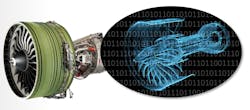The idea of virtualizing real world machines for performance analysis in the cloud has a fairly long history in the IT world with servers. Its use in the industrial world for asset operation and maintenance purposes is much more recent and not well understood by many potential users. But this scenario is likely to change rapidly with the increased focus on this technology being advanced by GE and others.
Explaining the coming influence of digital twins (aka virtualization) on industry at GE’s Minds + Machines 2016 event in San Francisco, Dimitri Volkmann, GE’s Digital Twin thought leader, started his presentation saying: “Digital twins are dynamic digital representations that enable companies to understand, predict and optimize the performance of their machines and business.”
Volkmann noted that the digital twin concept differs from other industrial digitalization trends in that it doesn't seek to replace the physical asset; instead, it enhances our understanding and use of those assets. “The first wave of digitalization was all about making paperwork transactions disappear,” he said. “But this second wave, focused on digitalizing the physical world, is not about making the real world assets disappear, but about pairing the assets’ data with the physical system that creates it. We look at what the asset means in the physical world in order to build business outcomes.”
Describing a digital twin as the result of combining data plus intelligence and enabling it with models based on the asset’s physics, machine learning and analytics, Volkmann said that, with one digital twin you can get detailed, high fidelity context of an asset. With many digital twins, such as a fleet of assets, you can learn and discover business-changing patterns.
Using examples of the benefits GE Aviation has achieved using digital twins, Volkmann said that anomaly detections based on sensor data from flights has been reduced by 15-30 days, lifecycle predictions for turbine blade models has resulted in $44 million in savings, and dynamic optimization to deliver optimal flight patterns and maintenance has resulted in $10 million in savings.
In all, GE is currently running more than 500,000 digital twins across its production sites, said Colin Parris, vice president of GE Software Research. “We use parts twins, products twins, process twins and system twins.”
Onstage at the Minds + Machines event, Parris demonstrated a voice-activated interactive session with a digital twin of a D11 steam turbine operating in California. Connected via the Predix System, Parris asked questions about possible rotor damage on the turbine and received analysis of the impact of this damage and advice on how to correct it with the least impact on production. The digital twin of the turbine was also able to provide a financial perspective on repair of the rotor and the resulting operational and financial impacts of that repair.
“The digital twin is a living model that drives business outcomes,” said Parris. “It consumes environmental and operations data and constantly updates itself with this information. It also reaches into the fleet of similar assets and acquires learning from them to drive outcomes. This enables the digital twin to predict and warn about failures as well as forecast opportunities.”
Parris explained in his demonstration that the digital operates in three stages: See, Think and Do. In the “See” phase, the digital twin gathers operations and environmental data to give a warning or prediction. It uses models of the asset to analyze and understand through Predix APM (Asset Performance Management). In the “Think” stage users can ask the digital twin questions. Based on user input, the digital twin runs simulations on Predix looking at historical data, fleet data and forecasts on costs and then reasons across this information. Finally, the “Do” stage is about the digital twin informing us on what needs to be done using info from APM to direct operator actions around the manual or automated options it offers.
“All of this can be done with Predix running on an edge device,” Parris added.
Microsoft’s HoloLens also made an appearance in the Digital Twin presentation as means of demonstrating an immersive augmented reality environment leveraging the digital twin. Parris interacted with the digital twin while using the HoloLens via voice commands and hand gestures.
At its Minds + Machines event, GE came out as strong proponent for the use of HoloLens or other heads up devices to free up the hands of operators to do work, rather than having to hold a mobile device between themselves and the environmental they are interacting with.
Shyam Krishnaswamy, senior manager of Technology Innovation Corporate Strategy at Exelon, spoke about their use of the digital twin, noting that Exelon’s goals around use of digital twins centers on maximizing the life of the company’s assets. He pointed out that the digital twin project at Exelon has not been an “easy journey, because were are not just creating models in a virtual world.” Exelon’s application of digital twins has been about “creating an exact twin of an asset and giving life to it to do useful what-if scenarios to get predictive,” he said.
Having started with a small digital twin pilot at one of the company’s power plants, Krishnaswamy said Exelon spent four to five months getting this pilot up and running. The first six weeks of that time was focused on prepping the data, getting blueprints of assets, etc., he said. Though Exelon could have outsourced this part of the project to GE, Krishnaswamy said, “We wanted to build it ourselves so we would fully understand the process.”
The pilot project has been so successful for Exelon that the company’s next step is extending it across “all of our generation assets,” Krishnaswamy said.
Summing up GE’s experience with its own use of the digital twin, as well as its experience with customers like Exelon, Parris said, “This convergence of operations with digital twins will profoundly change everything we know about industrial operations.”
About the Author
David Greenfield, editor in chief
Editor in Chief

Leaders relevant to this article:
